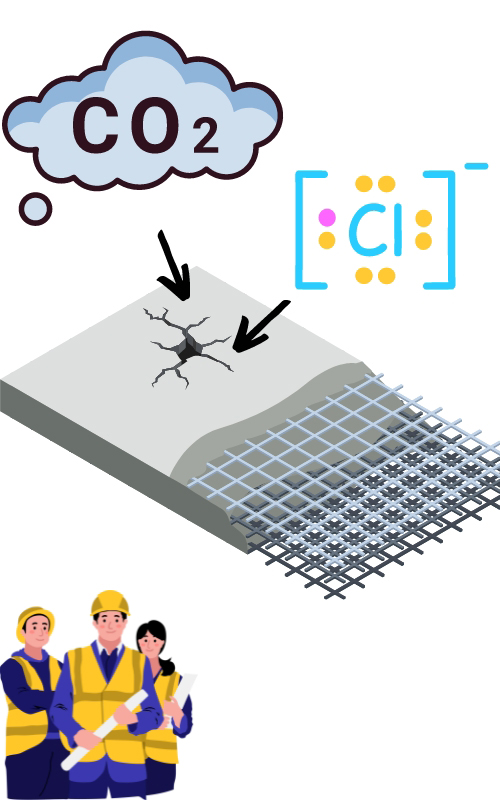Effects of carbonation and chloride ingress on the durability of concrete structures Scientific paper
Main Article Content
Abstract
The durability of concrete structures, which are designed for long-term use is predominantly determined by the resistance to chemical influences, i.e., the concrete’s ability to protect the reinforcement steel. The carbonation and the chloride ingress into concrete are the most significant causes of steel corrosion and the potential failure of the structure. The primary goal is to ensure that any significant damage does not occur during the structure's service life, primarily achieved by selecting an adequate thickness of the concrete cover. The issue is approached through calculations based on performance analyses, and the use of appropriate models for these chemical phenomena. The paper provides a brief overview and the methodology for analysing the impact on the durability of concrete structures in accordance with the leading international normative documents. The emphasis is on the recent changes introduced in second generation of European Eurocode standards. The consequences of the analysed phenomena are presented through the results of field tests conducted at salt factories, coke industries, and thermal power plants, and through laboratory tests. The tests were performed in order to develop a rapid prediction method for the measure of chloride ingress into concrete without the stimulating chloride ion migration by electricity, as an alternative to standardized tests.
Downloads
Metrics
Article Details

This work is licensed under a Creative Commons Attribution 4.0 International License.

Authors retain copyright and grant the journal right of first publication with the work simultaneously licensed under a Creative Commons Attribution license 4.0 that allows others to share the work with an acknowledgement of the work's authorship and initial publication in this journal.
References
CEB, Durable of Concrete Structures, Design Guide, T. Thelford, London, 1992, p. 112
Durability Design of Concrete Structures, RILEM R. 14, A. Sarja, E. Vesikari, Eds., E&FN Spon, London, 1996
M. G. Richardson, Fundamentals of durable reinforced concrete, CRC Press, London, 2002 (https://doi.org/10.1201/9781482272109)
Durability of Concrete – Design and construction, M. Alexander, A. Bentur, S. Mindess, Eds., CRC Press, Boca Raton, FL, 2017 (https://doi.org/10.1201/9781315118413)
Structural Concrete Textbook on behaviour, design and performance, 2nd ed., Vol. 3: Design of durable concrete structures, Manual-textbook, Ch. 5 (ISBN 978-2-88394-093-2) (https://doi.org/10.35789/fib.BULL.0053)
ISO 16204:2012: Durability-Service life design of concrete structures (https://www.iso.org/standard/55862.html)
ACI (American Concrete Institute), ACI 201. 2R-16: Guide to durable concrete, ACI Committee, 2016 (ISBN: 9781945487392)
ACI (American Concrete Institute), ACI 365.1R-17: Report on service life prediction, ACI Committee 365, 2017 (ISBN: 9781945487743)
CEN, European Standard EN 1990:2002: Eurocode – Basis of structural design, European Committee for Standardization, 2002
CEN, European Standard EN 1992:2004: Eurocode 2 – Design of Concrete Structures, European Committee for Standardization, 2004
CEN, European Standard EN 206-1:2000: Concrete: Specification, Performance, Production and conformity, European Standard, 2000
fib (Federation international du beton), Model Code for Service Life Design, Bull. 34, 2006 (https:// doi.org/10.35789/fib.BULL.0034)
fib (Federation international du beton), Model Code for concrete structures 2010, Ernst & Sohn, 2013 (ISBN: 978-3-433-03061-5)
R. Folić, Facta Universitatis, Series: Architect. Civil Eng. 7 (2009) 1 (https://dx.doi.org/10.2298/FUACE0901001F)
R. Folić, D. Zenunović, Facta Universitatis, Series: Architect. Civil Eng. 8 (2010) 45 (https://dx.doi.org/10.2298/FUACE1001045F)
S. Helland, Struct. Concrete 14 (2013) 10 (https://dx.doi.org/10.1002/suco.201200021)
Y. Zhou, B. Gencturk, K. Willam, A. Attar, J. Mater. Civ. Eng. 27 (2014) (https://dx.doi.org/10.1061/(ASCE)MT.1943-5533.0001209)
M. Aleksander, H. Baushausen, Cement and Concrete Research 122 (2019) 17 (https://dx.doi.org/10.1016/j.cemconres.2019.04.018)
S. Demis, G. Vagelis, G. Papdakis, J. Bridge Eng. 26 (2019) 100876 (https://dx.doi.org/10.1016/j.jobe.2019.100876)
S. Helland, in Proceedings f fib Int. Congress, Oslo, June 12–16, 2022
M. R. Geiker, M. A. N. Hendriks, B. Elsener, Sustain. Resilient Infrastruct. 8 (2003) 169 (https://dx.doi.org/10.1080/23789689.2021.1951079)
JWG (JWG 250/104-N25) Durability Report 2014, Durability Exposure Resistance Classes, a new system to specify durability in EN 206 and EN 1992, Leivestad, 2014
R. Folić, Z. Brujić, in Proceedings of MASE, September 28-29, 2023
CEN, European Standard prEN 1990:2021. Eurocode – Basis of structural and geotechnical design, European Committee for Standardization, 2021
CEN, European standard EN 206:2013 + A2:2021. Concrete - Specification, performance, production and conformity, European Committee for Standardization, 2013
CEN, European Standard FprEN 1992-1-1:2023. Eurocode 2 – Design of concrete structures – Part 1-1: General rules and rules for buildings, bridges and civil engineering structures, European Committee for Standardization, 2023
CEN, Background document to FprEN 1992-1-1:2023-04, Formal-Vote-Draft: Eurocode 2 - Design of concrete structures - Part 1-1: General rules and rules for buildings, bridges and civil engineering structures, CEN/TC 250/SC 2 N2087, 2023
R. Folić, D. Zenunović, Eng. Struct. 32 (2010) 1346 (https://dx.doi.org/10.1016/j.engstruct.2010.03.004)
D. Zenunović, N. Rešidbegović, R. Folić, in Proceedings of the 1st IC COMS 2017, Zadar, Croatia, pp. 407–413
D. Zenunović, N. Rešidbegović, R. Folić, Roman. J. Mater. 49 (2019) 80 (https://solacolu.chim.upb.ro/p80-87.pdf)
D. Zenunović, N. Rešidbegović, R. Folić, in Proceedings of 18th Int. Symp. MASE, Oct. 2019, pp. 511–518.





